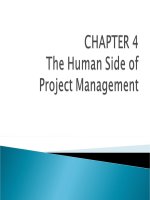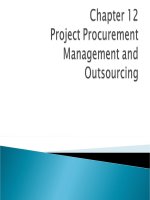Tài liệu Chapter 12: IT project manager doc
Bạn đang xem bản rút gọn của tài liệu. Xem và tải ngay bản đầy đủ của tài liệu tại đây (1.23 MB, 24 trang )
Describe the PMBOK® area called Project Procurement
Management.
Describe the six processes that make up Project
Procurement Management.
Describe the three general categories for
procurement-type contracts.
Define outsourcing, business process outsourcing,
and offshoring.
Describe the reasons why organizations outsource
projects and project components.
Describe the advantages and disadvantages of
outsourcing.
Describe several ways to improve the likelihood of
outsourcing success.
Is one of the nine PMBOK® areas
Focuses on the acquisition and management of
outside products and services
Project teams require resources and many of these
resources must be acquired externally
◦ e.g., office supplies, technology, printing services, etc.
Organizations can also outsource entire business
functions and business processes
◦
e.g., data centers, call centers, accounting functions, and
projects
Outsourcing was commonly called “subcontracting”
Project teams can be outsourcing buyers and sellers
The contract management and change control
processes are required to administer contracts or
purchase orders issued by authorized project team
members. Project Procurement Management also
includes administering any contract issued by an
outside organization (the buyer) that is acquiring the
project from the performing organization (the seller),
and administering contractual obligations placed on
the project team by the contract. (p. 269)
Plan Purchases
and Acquisitions
Making the decision as to what will be purchased or acquired as
well as determining the logistics of when purchases will be made
and how.
Plan Contracting Documenting the product, services, or results needed as well as
identifying potential sellers, vendors, suppliers, contractors,
subcontractors, or other service providers.
Request Seller
Responses
Obtaining bids, quotes, proposals, literature, and other information
from potential sellers or service providers.
Select Sellers Negotiating, selecting, and contracting with a seller for a particular
product or service.
Contract
Administration
Managing the relationship and contract between the buyer and
seller. This includes reviewing and documenting the seller’s
performance, contract changes, and taking corrective action when
necessary.
Contract Closure Completing and settling each contract after any open items or
settlements are resolved.
Begins by determining which project needs
can be fulfilled internally by the project team
◦
Which can be best fulfilled externally?
Focuses not only
what
can best be filled
internally or externally, but
◦
How
◦
When
◦
How Many
◦
And
Where
these products or services will be
acquired
Focuses on developing a procurement document such
as a request for proposal that can be used to solicit
bids, quotes, or proposal from prospective sellers
A common set of measures should be used to compare
and evaluate various proposals from sellers
Also includes the development of criteria for evaluating
sellers’ proposals
◦
For example, this may include the seller’s expertise,
experience, capability, and references
The buyer should strive to receive a reasonable
number of high-quality, competitive proposals
Buyers let prospective sellers know that requests
or bids are being sought by
◦
Holding conferences with prospective sellers so they
have a clear idea of what the buyer needs
◦
Advertising in newspapers, trade journals, or the Web
◦
Contacting a potential seller directly
The seller’s proposal should include not only the
price for the product or service, but also the
seller’s ability and willingness to provide what is
requested
After bids, proposals, or quotations are
received, the buying organization must select
a seller
The criteria used in the Plan Purchases and
Acquisition process should be used
Although price or cost may be an important
criteria, other criteria should be considered
as well









